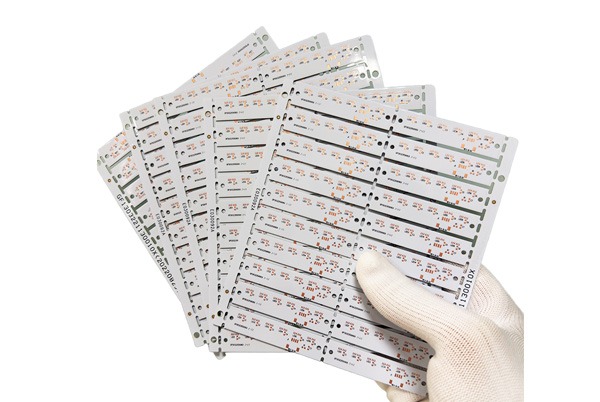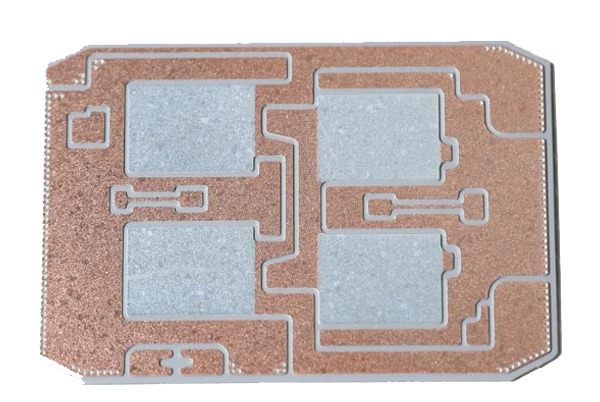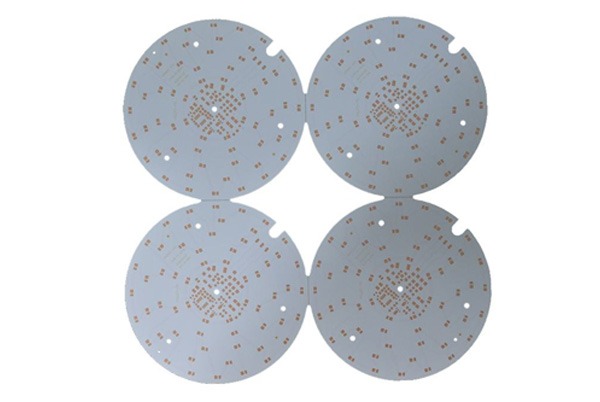Inhaltsübersicht
Was ist eine Leiterplatte auf Metallbasis?
Eine metallbasierte Leiterplatte (Metal Core PCB, abgekürzt MCPCB) ist eine innovative Leiterplattenlösung, bei der Metallmaterial als Substrat verwendet wird. Im Vergleich zu herkömmlichen FR-4-Substraten nutzt MCPCB seine einzigartige Metallsubstratstruktur, um die während des Schaltkreisbetriebs entstehende Wärme effizient von kritischen Bauteilbereichen zu unkritischen Bereichen wie Kühlkörpern oder dem Metallsubstrat selbst zu leiten und so ein außergewöhnliches Wärmemanagement zu erreichen.
Unter diesen ist das von TOPFAST ist eine wichtige Kategorie von Leiterplatten auf Metallbasis, die unter den technischen Anwendungsbereich von kupferkaschierten Laminaten auf Metallbasis fallen. Dieses Produkt verwendet hochwertiges Aluminiummaterial als Kernsubstrat und kombiniert hervorragende Wärmeleitfähigkeit mit zuverlässigen Isolationseigenschaften. Es eignet sich besonders für Anwendungen mit hohen Anforderungen an die Wärmeableitung, wie z. B. LED-Beleuchtung und Leistungsmodule. Mit fortschrittlichen Produktionsprozessen und strengen Qualitätskontrollen bietet TOPFAST leistungsstarke und äußerst zuverlässige Aluminiumsubstratlösungen.
Analyse der Struktur von Metallkern-Leiterplatten (MCPCB)
Metallkern-Leiterplatten (MCPCB), auch bekannt als isolierte Metallsubstrate (IMS) oder isolierte Metall-Leiterplatten (IMPCB), sind auf eine effiziente Wärmeableitung ausgelegt. Ihre typische Mehrschichtstruktur zeichnet sich durch eine symmetrische Schichtverteilung aus. Bei einer 12-lagigen Leiterplatte beispielsweise befindet sich der Metallkern in der Mitte, flankiert von sechs gleichmäßigen Nichtmetallschichten auf jeder Seite, um strukturelle Stabilität und eine ausgewogene Wärmeübertragung zu gewährleisten.
Kernstrukturkomponenten
Die laminierte Struktur von MCPCB besteht in erster Linie aus den folgenden Schlüsselelementen:
- Schaltungsebene: This is the copper foil layer responsible for electrical connections. To meet high-current transmission requirements, TOPFAST MCPCB utilizes thick copper foil designs, with standard thicknesses ranging from 35 μm to 280 μm, ensuring both current-carrying capacity and reliability.
- Wärmedämmschicht: Dies ist die Kerntechnologie des Aluminiumsubstrats. Diese Schicht besteht in der Regel aus einem speziellen Polymer, das mit Keramikpartikeln gefüllt ist, und bietet eine ausgezeichnete Wärmeleitfähigkeit, eine hohe elektrische Isolationsfestigkeit und mechanische Belastbarkeit. TOPFAST verwendet für diese Isolierschicht hochwertige Materialsysteme, wie beispielsweise IMS-H01 und LED-0601. Diese Materialien zeichnen sich durch einen minimalen Wärmewiderstand aus, leiten Wärme effektiv weiter und halten langfristigen thermischen Belastungen stand, um eine lange Lebensdauer des Produkts zu gewährleisten.
- Metall-Grundschicht: Diese Schicht dient als strukturelle Stütze und primärer Wärmeableitungspfad und besteht in der Regel aus hochwärmeleitfähigem Aluminium oder sogar noch leitfähigerem Kupfer. Die Metallgrundplatten von TOPFAST bieten nicht nur eine hervorragende Wärmeleistung, sondern eignen sich auch für präzise mechanische Bearbeitungen wie Bohren und Stanzen, um komplexen Anwendungsanforderungen gerecht zu werden.
TOPFAST Aluminium-Substrat: Integration überlegener Leistung
Die Aluminiumsubstrate von TOPFAST sind repräsentative Produkte in der Kategorie der metallbasierten kupferkaschierten Laminate und vereinen hervorragende Wärmeleitfähigkeit, zuverlässige elektrische Isolierung und ausgezeichnete mechanische Verarbeitbarkeit. Wir halten uns strikt an Oberflächenbehandlungsstandards wie Vergoldung, Immersionsvergoldung, Zinnspritzen (einschließlich bleifreier Verfahren) und OSP-Antioxidation, um sicherzustellen, dass jede Platine auch unter anspruchsvollen Bedingungen eine hohe Leistung und lange Lebensdauer beibehält.

Arten und Vorteile von Metallkern-Leiterplatten
Metallkern-Leiterplatten umfassen in erster Linie drei Arten: Leiterplatten auf Aluminium-, Kupfer- und Eisenbasis. Die folgende Tabelle enthält einen detaillierten Vergleich der wichtigsten Eigenschaften von Leiterplatten auf Aluminium- und Kupferbasis sowie eine systematische Zusammenfassung der allgemeinen technischen Vorteile dieser Kategorie von Leiterplatten.
| Aspekt | Aluminium-basierte Leiterplatte | Kupferbasierte Leiterplatte |
|---|---|---|
| Kernmerkmale | Ausgewogene Wahl hinsichtlich Kosten, Gewicht und Leistung | Erstklassige Wärmeleitfähigkeit und Leistung für extreme Bedingungen |
| Wärmeleitfähigkeit | 5 – 2.0 W/(m·K) | Up to 386 W/(m·K) |
| Wärmeausdehnungskoeffizient | Approx. 25 μm/m°C | Approx. 17 μm/m°C |
| Typische Substratdicke | 2 – 8 mm | An die Designanforderungen angepasst |
| Schälfestigkeit | > 9 lb/in | > 9 lb/in |
| Durchbruchspannung | > 3000 V | > 3000 V |
| Flammwidrigkeitsklasse | UL 94V-0 | UL 94V-0 |
| Die wichtigsten Vorteile | • Excellent thermal conductivity and dissipation • Relatively lightweight • TOPFAST-Empfehlung: Kostengünstige Wahl | • Superior thermal performance • Better thermal stability • TOPFAST-Lösung: Entwickelt für hohe Leistungsanforderungen |
| Häufige Arten | Einlagige, zweilagige, mehrlagige Aluminium-Leiterplatten | Sintered, embedded copper, cold plates, etc. |
Umfassende technische Vorteile von Metallkern-Leiterplatten
| Vorteil | Description | Value to Customers |
|---|---|---|
| Efficient Heat Dissipation | Thermal conductivity (1-7 W/m·K) is 8-9 times that of FR-4, rapidly reducing component operating temperatures. | Increases product power density, extends device lifespan, and enhances long-term reliability. |
| Structural Robustness | The metal core layer provides high mechanical strength, with strong resistance to impact and vibration. | TOPFAST products are particularly suitable for harsh environments such as automotive and industrial applications. |
| Flexibilität bei der Gestaltung | The metal layer can be etched into custom heat sinks (e.g., TOPFAST’s Integrated Heat Dissipation Structure), simplifying system design. | Saves space and cost associated with external heat dissipation components, enabling more compact product designs. |
| Hohe Verlässlichkeit | Low coefficient of thermal expansion reduces thermal stress, significantly minimizing solder joint fatigue and component separation risks. | Reduces field failure rates, lowers maintenance costs, and safeguards brand reputation. |
| Eco-Friendly Materials | Metal substrates (aluminum, copper) are recyclable, aligning with green manufacturing trends. | Helps customers comply with environmental regulations and build a green product image. |
Prozessspezifikationen für Leiterplatten mit Metallkern
I. Laminierungsstrukturdesign
- A symmetrical lamination structure is adopted to ensure balanced layer distribution on both sides of the metal layer.
- Maintain symmetrical copper layer distribution to prevent board warping.
- Standard dielectric layer thickness: 0.003–0.006 inches.
II. Besondere Verfahrensvorschriften
- Plated Through-Hole Treatment: Metal parts must undergo insulation treatment.
- Bohrprozess: Diamond-coated metal cutting saws are used.
- Lötmaske Prozess: White solder mask ink is preferred for LED boards.
III. Detaillierte Konstruktionsspezifikationen
1. Border Design Specifications
- Maintain a minimum distance of ≥1.5mm between the aluminum board edge and SMD component silkscreen/plug-in hole pin edges.
- Internal and external slot chamfer range: 0.8–1.0mm.
- Open a full slot when the distance between component hole walls is <1.15mm.
- Standard aluminum board thickness: 1.5mm (maximum not exceeding 8mm).
- For thickness >1mm, the narrowest border dimension should be ≥3mm.
- For thickness <1mm, the narrowest border dimension should be ≥5mm.
2. Surface Treatment Options
- Multiple processes available: HASL, ENIG, Gold Plating, etc.
- HASL is not recommended for copper-based boards.
IV. Prozessspezifikationen für verschiedene Metallkern-Leiterplatten
Single-Sided Metal Core PCB
| Prozess-Typ | Drilling Specifications | Besondere Anforderungen |
|---|---|---|
| PP Lamination | ① Aspect ratio 10:1 ② Component holes ≥0.8mm ③ Vias 0.3–0.8mm | Counterbore ≥1.0mm Angle 82–165° |
| Dielectric Bonding | ① Hole wall spacing ≥0.5mm ② Component holes ≥0.8mm ③ Vias 0.3–0.8mm | Metal core tolerance ±0.1mm |
Application Scope: LED lighting and other scenarios requiring heat dissipation.
Double-Sided/Multi-layer Metal Core PCB
- Drilling Specifications:
- Aspect ratio 10:1
- Component holes ≥1.0mm
- Vias 0.3–0.8mm
- Board thickness range: 0.8–3.5mm (maximum 8mm)
Application Scope: Communication equipment, electronic control systems.
Sintered Metal Core PCB
- Copper Block Specifications:
- Thickness: 1.0/1.5/2.0/3.0mm
- Area: 50×50mm to 200×200mm
- Design Key Points:
- Connection areas must have exposed copper.
- At least one 0.3mm vent hole per 20×20mm area.
- Solder mask dams to prevent solder flow.
- Surface Process: ENIG (supports 2 reflow cycles).
Application Scope: Heat dissipation solutions for high-power components.
Embedded Copper Metal Core PCB
- Copper Block Requirements:
- Size: 3×3mm to 60×80mm
- Thickness: 1.0–3.0mm
- Spacing: ≥7mm
- Process Limitations:
- 20mil keep-out zone around copper blocks.
- HDI and resin plugging are not supported after lamination.
- Lamination cycles ≤2.
Application Scope: Scenarios requiring localized high heat dissipation.
Cold Plate Process
- Standard aluminum plate thickness: 1.5mm
- Drilling rules follow standard PCB specifications.
- Supports HASL, ENIG, and Gold Plating processes.
Application Scope: High-reliability fields such as aerospace and power modules.
Rigid-Flex Metal Core PCB
- Combines the advantages of rigid metal cores and flexible circuits.
- Component holes require ≥1.2mm.
- Supports various structures, including cold plates, sintered, and embedded copper.
Application Scope: Applications requiring both heat dissipation and assembly flexibility.
V. Zusammenfassung der Prozessvorteile
Through TOPFAST’s professional process control, metal core PCBs ensure:
- Excellent thermal management performance.
- Higher mechanical strength.
- Adaptability to complex environments.
- Meeting high-density installation requirements.
All processes undergo strict quality control, providing customers with reliable heat dissipation solutions.

Umfassende vergleichende Analyse von Metallkern-Leiterplatten und FR-4-Leiterplatten
Vergleich der Kernmerkmale
| Charakteristisch | Metal Core PCB (MCPCB) | FR-4 PCB |
|---|---|---|
| Wärmeleitfähigkeit | 1-7 W/m·K | 0.3-0.4 W/m·K |
| Strukturelle Festigkeit | High rigidity, excellent vibration resistance | Medium rigidity |
| Thermisches Management | Direct heat conduction through the metal layer | Relies on thermal vias |
| Kostenniveau | Relativ hoch | Kostengünstig |
| Processing | Special cutting requirements | Standard process flow |
Material- und Strukturunterschiede
Metallkern-Leiterplatte
- Base Material: Aluminum or copper metal substrate
- Structure: Three-layer composite (copper foil + dielectric layer + metal core)
- Surface Treatment: Insulating coatings such as aluminum oxide
- TOPFAST Solution: Provides optimized laminated structure design
FR-4 PCB
- Base Material: Glass fiber reinforced epoxy resin
- Structure: Supports flexible designs from single to multi-layer
- Features: Stable dielectric performance, wide processing adaptability
Eingehende Analyse der Leistungsparameter
Thermische Leistung
- Metal Core PCB: Thermal conductivity approximately 600 times that of FR-4, suitable for high heat dissipation scenarios
- FR-4 PCB: Poor thermal conductivity, glass transition temperature 130-180°C
Mechanical Characteristics
- Metal Core PCB: Thickness range 0.8-4mm, excellent mechanical strength
- FR-4 PCB: Thickness range 0.2-5mm+, good processing flexibility
Kosten-Nutzen-Analyse
Metallkern-Leiterplatte
- Material Cost: Higher due to metal substrate and special insulation layers
- Process Cost: Specialized processing equipment, high process complexity
- TOPFAST Value: Cost control through optimized production processes
FR-4 PCB
- Material Cost: Affordable base materials, suitable for mass production
- Process Cost: Mature process route, significant scale effects
Anwendungsszenario-Leitfaden
Metallkern-Leiterplattenanwendungen
- High-power LED lighting systems
- Power conversion modules
- Automotive electronic control systems
- Industrial motor drives
- TOPFAST Expertise: Customized solutions for high heat dissipation requirements
FR-4 PCB Applications
- Computers and peripherals
- Communication infrastructure
- Unterhaltungselektronik
- General industrial control
Auswahlstrategie für Leiterplatten mit Metallkern
Based on Heat Dissipation Requirements
- Aluminum substrate: Thermal conductivity 1.0-6.0 W/(m·K), optimal cost-performance
- Copper substrate: Thermal conductivity ~388 W/m·K, high-performance choice
- Ceramic substrate: Thermal conductivity 150-220 W/(m·K), special applications
Based on the Operating Environment
- High-temperature environment: FR-4 high Tg board or aluminum substrate
- Conventional environment: Standard FR-4 material
Based on Electrical Performance
- High-frequency applications: Specialized high-frequency materials
- Conventional applications: Standard FR-4 materials
Based on Mechanical Requirements
- Lightweight requirements: The Aluminum substrate has obvious advantages
- Cost-sensitive scenarios: Comprehensive evaluation of lifecycle costs
Wichtige Entscheidungspunkte bei der Auswahl
- Define Core Requirements: Heat dissipation performance vs. cost control
- Evaluate Operating Environment: Temperature range, vibration conditions
- Analyze Signal Requirements: Frequency characteristics, impedance control
- Consider Manufacturing Factors: Process feasibility, delivery cycle
- Leverage Professional Support: TOPFAST provides comprehensive technical consultation
Through systematic evaluation processes and professional material selection, the most suitable PCB solution can be matched for specific applications, achieving the optimal balance between performance, reliability, and cost.

So wählen Sie die richtige Leiterplatte mit Metallkern für bestimmte Anwendungen aus
Selecting a metal core printed circuit board (MCPCB) requires a systematic evaluation framework.
I. Kernauswahldimensionen
1. Thermal Performance Requirements
- Aluminium-Substrat: Thermal conductivity 1.0-6.0 W/(m·K), optimal cost-performance
- Suitable for: High-power LED lighting, power conversion modules
- Copper Substrate: Thermal conductivity ~388 W/(m·K), excellent heat dissipation
- Suitable for: Automotive electronics, high-power lasers
- Ceramic Substrate: Thermal conductivity 150-220 W/(m·K), excellent high-frequency characteristics
- Suitable for: IGBT, SiC power modules
2. Operating Environment Temperature
- High-temperature environment (>150°C): Aluminum substrate or FR-4 high Tg material
- Conventional environment: Standard FR-4 sufficient
3. Signal Integrity Requirements
- High-frequency applications: Choose PTFE or Rogers high-frequency materials
- Conventional applications: Standard FR-4 offers a better cost advantage
II. Alternative Lösungen zur Wärmeableitung für Leiterplatten mit Metallkern
1. Ceramic Substrate Solutions
- Aluminum nitride substrate: Thermal conductivity 170-200 W/(m·K)
- Aluminum oxide substrate: Thermal conductivity 30-40 W/(m·K), significant cost advantage
2. Composite Material Solutions
- Aluminum-based composites: Thermal conductivity 10-20 W/(m·K)
- Copper-based composites: Thermal conductivity 180-300 W/(m·K)
3. Advanced Heat Dissipation Technologies
- Embedded heat pipes: Equivalent thermal conductivity >5000 W/(m·K)
- Vapor chamber technology: Temperature difference control accuracy ±2°C
- Nano-silver sintering: Thermal conductivity >200 W/(m·K)
III. Auswahlentscheidungsmatrix
| Anwendungsszenario | Recommended Solution | Die wichtigsten Vorteile |
|---|---|---|
| High-power density LED | Aluminum substrate + heat pipes | Balanced heat dissipation efficiency and cost |
| Automotive power modules | Copper substrate/Ceramic substrate | High reliability, high temperature resistance |
| Unterhaltungselektronik | FR-4 + heat sinks | Optimal cost |
| Luft- und Raumfahrt | Ceramic substrate + vapor chamber | Extreme environment adaptability |
Anwendungsbereiche
Metal Core Printed Circuit Boards (MCPCBs) are widely used in the following key areas due to their excellent thermal performance and reliability:
- LED-Beleuchtung: High-power spotlights, general lighting, and backlight modules
- Kfz-Elektronik: Electronic control systems and power management modules for electric/hybrid vehicles
- Leistungselektronik: Motor drives, solid-state relays, and high-frequency power equipment
- Neue Energie: Solar inverters and photovoltaic control systems
- Industrielle Steuerung: High-precision motion controllers and automation equipment drive systems
Über TOPFAST
Headquartered in China, TOPFAST is a one-stop PCB solution provider specializing in rapid prototyping and small-batch manufacturing. We focus on overseas markets and are committed to providing professional and reliable PCB manufacturing services to global customers.
Our Advantages:
- Professional Expertise: Specializing in metal core PCBs, delivering high-quality manufacturing services
- Efficient Delivery: Strictly adhering to our “high quality, fast delivery” service standard
- Customer Trust: Earning high international market recognition through consistent product quality and on-time delivery commitments
TOPFAST remains committed to customer satisfaction as our core principle, striving to become the most trusted PCB partner for global clients.
Zusammenfassung
Metal Core Printed Circuit Boards (MCPCB) represent a core technology in modern electronic thermal management. By combining metal substrates (such as aluminum and copper) with highly thermally conductive dielectric layers, they achieve heat dissipation efficiency far superior to traditional FR-4 substrates. Widely used in high-power applications like LED lighting, automotive electronics, new energy, and industrial control, MCPCBs enhance device reliability and power density while effectively addressing thermal management challenges in high-temperature environments. With the development of emerging technologies like 5G and electric vehicles, metal core PCBs continue to make breakthroughs in material innovation (such as ceramic substrates and composite materials) and process optimization (such as embedded heat dissipation), providing more efficient thermal solutions for high-power electronic devices.
Häufig gestellte Fragen zu MCPCB
A: Thermische Leistung: The thermal conductivity of metal core PCBs (1-7 W/m·K) is significantly higher than that of FR-4 (0.3-0.4 W/m·K), improving heat dissipation efficiency by approximately 8-9 times.
Strukturelle FestigkeitMetallkernplatten (z. B. Aluminium, Kupfer) bieten eine höhere Steifigkeit und eine bessere Beständigkeit gegen Vibrationen und Stöße.
Kosten und Ablauf: Metallkern-Leiterplatten sind teurer und erfordern spezielle Verfahren (z. B. Metallkernschneiden, Isolierungsbehandlung), während FR-4-Leiterplatten von ausgereiften Verfahren und geringeren Kosten profitieren.
A: Yes, aber das Design muss die folgenden Bedingungen erfüllen:
Symmetrische StrukturDie Anzahl der Schichten auf beiden Seiten des Metallkerns muss einheitlich sein (z. B. hat eine 6-lagige Metallkern-Leiterplatte einen Metallkern in der Mitte mit 3 Schichten auf jeder Seite).
IsolierungsbehandlungEine dielektrische Schicht mit hoher Wärmeleitfähigkeit muss die Metallschicht von der Schaltungsschicht isolieren, um Kurzschlüsse zu verhindern.
ProzessbeschränkungenBeim Bohren müssen Metallrückstände vermieden werden, und die Lochwände müssen isolierend verfüllt werden.
A: Aluminium-basierte Platten:
Advantages: Lower cost, lightweight, and thermal conductivity (1-6 W/m·K) suitable for most applications (e.g., LED lighting, power modules).
Anwendbare Szenarien: Anforderungen an die Wärmeableitung bei mittlerer bis geringer Leistung.
Kupferbasierte Leiterplatten:
Advantages: Excellent thermal conductivity (~388 W/m·K), suitable for high-power devices (e.g., automotive LiDAR, high-power motor drivers).
Nachteile: Höhere Kosten, höheres Gewicht und erfordern eine Antioxidationsbehandlung.
A: Ja, die folgenden Lösungen können die Wärmeableitung weiter verbessern.:
Kühlkörper: Vergrößern Sie die Wärmeableitungsfläche durch Lamellenstrukturen, die in passiver (natürliche Konvektion) und aktiver (Luft-/Flüssigkeitskühlung) Ausführung erhältlich sind.
Wärmerohr/Dampfkammer: Embedded heat pipes (equivalent thermal conductivity >5000 W/m·K) or vapor chambers (temperature difference ≤2°C) for localized high-temperature areas.
Wärmeleitmaterialien: Zum Beispiel Wärmeleitpaste oder keramikgefüllte Polymere, um Mikrospalten zwischen Chips und der Metallkernplatine zu füllen.
A: Elektrische IsolierungDer Metallkern muss durch eine dielektrische Schicht (z. B. Aluminiumoxid) von der Schaltungsschicht isoliert werden, um Kurzschlüsse zu verhindern.
Lochgröße und -abstand:
Component holes ≥0.8mm, vias 0.3-0.8mm, and the spacing between hole walls and the metal core must be ≥0.5mm.
Wenn der Abstand zwischen den Lochwänden < 1,15 mm beträgt, müssen Vollschlitze erstellt werden, um Spannungskonzentrationen zu vermeiden.
Anpassung der WärmeausdehnungDer Wärmeausdehnungskoeffizient (CTE) des Metallkerns und der Komponentenmaterialien sollte ähnlich sein, um Risse in den Lötstellen aufgrund thermischer Belastung zu vermeiden.
